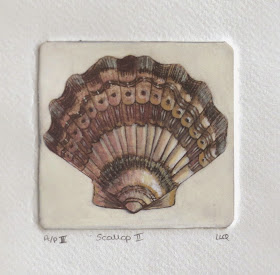 |
| Scallop A/P1 dry point 8x7.5cm ©2015Lisa Le Quelenec |
Due to the addictive nature of scratching away at pieces of acrylic perspex I went home and prepared a further five plates that week. This scallop was one that I did to have as a comparison with the previous zinc plate etching. I readily hang my head in shame at the mucky edges where I didn't clean the plate properly and I hold my hands up to the fact that I really need a lot more practice at inking up. But I figure the more mistakes I make the better I will be for it. I always have learnt by doing...
 |
| Scallop A/P2 dry point 8x7.5cm ©2015Lisa Le Quelenec |
A second pass this time using a pre watercoloured handmade paper for chine colle. The paper I used was a kind of lace paper and with hindsight I should have probably used one without holes running through it as it made it incredibally difficult to apply the gum arabic which was used to bond it to the paper as it went through the press. I have learnt so many things during each and every print.
 |
| Scallop A/P3 dry point & mixed media 8x7.5cm ©2015Lisa Le Quelenec |
This is a third pass from the plate but this time I have worked into it with watercolour and gouache making a mixed media version.
 |
| Spots! A/P2 dry point 3.5x7.5cm ©2015Lisa Le Quelenec |
Spots! was the smallest dry point that I did at only 3.5x7.5cm and was on a tiny left over piece that I was going to throw away. I'm glad that I didn't though as I think it works quite well.
The time that I spent printing off the dry point plates hadn't left me much time to ink up and print the collagraph samples that I had done. In this session I only managed a couple. Collagraph printing was the reason that I had signed up to this course in particular so it was kind of ironic that I had spent so much time in another and very different area.
Rather than do one board of samples to see how the different surfaces would print I had done a set of nine with the collaged elements loosely relating to each other. When I had sat down to make the sample board I had been thinking of the traditional embroidery samplers and how people had practiced groups of stitching which had led to separate contained boards.
 | |||
| Collagraph sample boards all backed onto pieces of mountboard; |
A key of materials used to make the samples:
1 paper tags with string and punched shapes. The blue paper was flocked.
2 plastic lace flowers and a strip of cotton lace to compare.
3 snowflake sequins and a real feather.
4 cellotape, masking tape, magic tape and plastic photo corners.
5 medium and rough acrylic texture paste and a glass beads texture paste.
6 paper fibre acrylic texture paste, kitchen towel and a fragment of fabric.
7 embossed wall paper and a handmade lace paper.
8 sand, mountboard and a section of the mountboard peeled away to expose a middle layer.
9 different texture ribbons and a piece of ricrac.
 |
| Sample board 4 collograph ©2015Lisa Le Quelenec |
This is the second pass as the first was far too heavy on the ink to actually see any of the texture and detail from the plate.
I thought the plastic photo corners made a good little row of beach hut roofs. The yellow on the pale hut isn't a clever bit of inking but a piece of the shellack that adhered to the paper. A lucky accident I think as I like the addition of the colour. I think I would have had a better print if I had wiped more ink of the plate. I am finding with every print making process the art of good printing is knowing how much and particularly how little ink to leave on the plate.
 |
| A/P1 Collagraph Plate 9 ©2015Lisa Le Quelenec |
 |
| A/P2 Collagraph Plate 9 ©2015Lisa Le Quelenec |
On the left the first run through the press dampened paper and too much ink and on the right the second run through the press with no added ink and dry paper. This was much closer to my intended image.
So much to learn and so little time.....

Good morning Lisa!... How rich your newest projects seem in comparison to your last attempts.
ReplyDeleteJust proves that new mediums and processes demand time spent to develop a learning curve to understand and assimilate the new vocabulary and knowledge>
Sure is happening here... and your complete sense of enjoyment shows through clearly in what you have produced!
Sail onward!... and Happy Beach Combing!
Good Printmaking!
Warmest regards,
Bruce
Hi Bruce, thank you. It's a steep learning curve for sure and I am making lots of uglies. It's great to be so challenged and stretched out of my comfort zone and I'm looking forward to seeing how these new experiences will feed into my normal studio practice.
ReplyDeleteHopefully it'll soon be a case of land ahoy and not where's the life raft!
Best wishes.
I love seeing your experiments and learnings - for me, they all look great even those you think are mistakes or not quite right yet. But so much to learn!!! I know you will take all you are learning to another level when it comes time and thanks so much for sharing!
ReplyDeleteBeautiful and fascinating. Warm greetings from Montreal, Canada. :)
ReplyDeleteRhonda, thank you so much! My mind has been abuzz with all the possibilities that these techniques are opening up. It has been so much fun.
ReplyDeleteHi Linda, thank you.